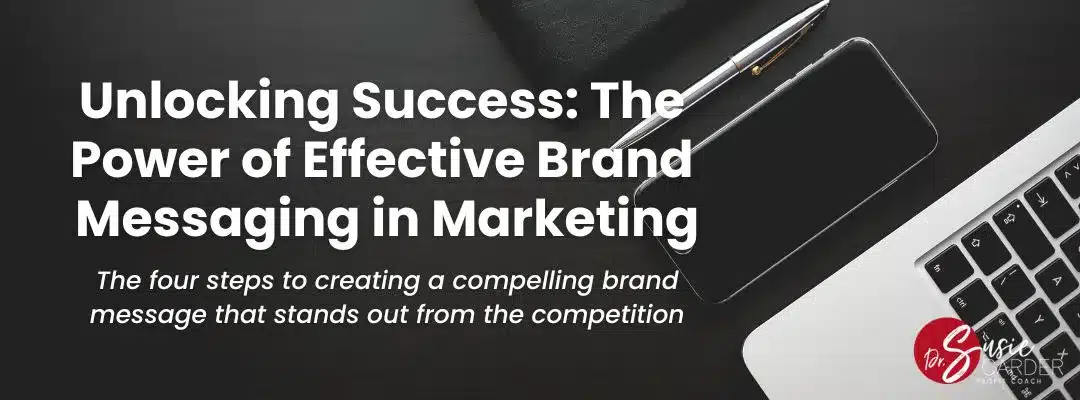Brand messaging refers to the underlying value proposition conveyed and the language used in your content. It’s what makes buyers relate to your brand by inspiring them, persuading them, motivating them, and ultimately making them want to buy your product. It’s not just the words you use; it’s also the feeling those words create for your customers. In essence, your brand messaging is the bridge between your brand and your target audience.
Part One: Understanding the Brand Messaging Framework
Overview of a Brand Messaging Framework
A brand messaging framework serves as the architectural blueprint of your brand’s communication. It is a strategic tool that outlines how your brand communicates its unique value proposition to your target audience. The framework encapsulates the essence of your brand and systematically communicates it in a cohesive and consistent manner across various platforms. In simpler terms, the comprehensive guide guarantees that you align every piece of content you produce with your brand’s identity, values, and goals.
Key Components of a Brand Messaging Framework
A robust brand messaging framework primarily consists of the following key components:
- Brand Positioning – This defines where your brand stands in the market in relation to your competitors. It’s your unique differentiator that sets you apart.
- Brand Promise – This is a declaration of your commitment to your customers. It’s what they can expect from every interaction with your brand.
- Brand Voice – Your brand voice refers to the personality and emotion infused into your brand communication. It’s how you convey your brand message.
- Brand Story – This is your brand’s narrative. It’s how you connect with your audience on an emotional level, often by sharing the origins, mission, and vision of the brand.
- Value Proposition – The value proposition is a concise explanation of what your brand offers, how it solves your customer’s needs, and why it’s better than the alternatives.
- Tagline – A memorable and punchy phrase that encapsulates the overarching benefit that your brand provides.

Example of a Brand Messaging Framework: Target
Let’s consider the well-known retail giant, Target, to illustrate the elements of a brand messaging framework in action:
- Brand Positioning – Target positions itself as an affordable yet trendy retailer. It’s a one-stop shop for chic, quality products at reasonable prices. They are not the cheapest in the market, but they offer excellent value for money through superior quality and variety.
- Brand Promise – Target promises to make shopping a joyful experience. The goal is to ensure that customers consistently have an enjoyable, hassle-free shopping experience, whether it’s in-store or online.
- Brand Voice – Target’s brand voice is friendly, upbeat, and inclusive. They speak like a knowledgeable friend, offering advice and solutions for a variety of needs.
- Brand Story – Target is committed to building strong, safe, and healthy communities. They have gained recognition for their efforts in community investment, sustainability, and dedication to ethical sourcing and corporate responsibility.
- Value Proposition – Target offers a wide range of stylish and quality products at a competitive price point, from home essentials to clothing and electronics. More than just a retail store, they offer a convenient and enjoyable shopping experience.
- Tagline – Target’s tagline, “Expect More. Pay Less,” reinforces its value proposition, promising quality products at affordable prices.
Target’s brand messaging framework clearly communicates its unique value proposition and brand promise to its audience, consistently across all platforms, thus creating a strong connection with its customers. By understanding and effectively leveraging these components, businesses can ensure their brand messaging hits the mark every time.
Part Two: Crafting a Powerful Brand Message
Steps to Develop a Strong Brand Message
Designing a potent brand message involves a strategic and creative process that encapsulates the essence of your brand and effectively communicates it to your target audience. Here are some key steps to craft an impactful brand message:
- Understand Your Audience: The first step in creating a potent brand message is understanding your target audience. Who are they? What are their needs, desires, and pain points? Once you understand your audience, you can tailor your brand message to resonate with them on a deeper level.
- Identify Your Unique Value Proposition (UVP): What sets you apart from your competitors? Your UVP should clearly articulate the unique benefits your product or service offers and why it’s the preferred choice for your customers.
- Define Your Brand’s Mission, Vision, and Values: These elements are the heart of your brand messaging. They communicate why you exist (mission), what you aspire to be (vision), and what principles guide your business dealings (values).
- Develop Your Brand Voice: Your brand voice is the personality of your brand. Whether it’s professional, friendly, informative, or whimsical, your brand voice should reflect your brand’s personality and be consistent across all platforms.
- Create a Memorable Tagline: A powerful tagline succinctly encapsulates the essence of your brand and leaves a lasting impression.
Case Study: Successful Brand Messaging Examples
Nike is a prime example of successful brand messaging. Their tagline, “Just Do It”, is not just a catchy slogan; it’s a rallying cry that resonates with their target audience’s desire for achievement and self-improvement. Nike’s branding consistently communicates a message of determination, drive, and the thrill of victory, which aligns perfectly with its product offering. This strong, cohesive brand messaging has allowed Nike to forge a deep emotional connection with their audience and maintain a leading position in the market.

Another noteworthy example is Apple, which has captivated its audience with its simple yet powerful message: “Think Different.” This tagline, combined with its innovative product design, communicates a clear and potent brand message about individuality and creativity. Apple’s brand message is consistently reinforced through its sleek aesthetic, innovative product design, and industry-leading technology. These examples underscore the immense power of effective brand messaging in not only communicating your brand’s value but also forging a strong emotional bond with your audience.
Part Three: Implementing Your Brand Message Across Platforms
Consistency in Brand Messaging
Maintaining consistency in brand messaging is pivotal to creating a strong brand identity. Consistency ensures that your brand is easily recognizable and dependable, fostering trust with your audience. It’s important to ensure that your brand message is uniform across all communication touchpoints – from your website, email newsletters, and social media posts. All elements of your brand messaging framework – your brand voice, promise, positioning, story, value proposition, and tagline – should be harmoniously aligned, thereby reinforcing your brand identity at every interaction.
Adapting Your Brand Message for Different Platforms
Consistency is important, but it’s also crucial to adjust your brand message for each platform and its audience. For instance, the tone and style of your message may be more formal on LinkedIn, while on Instagram, a more casual and vibrant tone may be more effective. Content length and depth can differ across platforms. Use longer posts for your blog or LinkedIn, and shorter, catchy posts for Twitter.
However, regardless of the platform, your brand’s core message, personality, and values should always shine through. This ensures that whether a customer reads a blog post, sees a tweet, or receives an email, they are always interacting with a consistent, authentic brand.
As you adapt your brand message for each platform, remember to track and measure its impact. This will help you understand what resonates with your audience on each platform, allowing you to continuously refine and improve your brand messaging strategy.
Part Four: Evaluating and Refining Your Brand Messaging
Importance of Regular Brand Message Reviews
Just as your brand grows and evolves, so should your brand messaging. Conducting regular brand message reviews is a crucial practice that ensures your message continues to align with your brand’s mission, vision, and values while resonating with your target audience. Regularly assessing your brand messaging can help find any inconsistencies or gaps that may have occurred, allowing for timely fixes. These regular check-ins ensure that your brand messaging remains impactful, relevant, and truly representative of your brand.
Strategies for Refining Your Brand Messaging over Time
Refining your brand messaging is not a one-off task but an ongoing process. Here are some strategies to guide you:
- Stay Informed about Your Audience: Market trends and customer preferences are not static; they change over time. Regularly updating your understanding of your audience—learning their evolving needs, wants, and pain points—can steer your brand messaging to remain relevant and engaging.
- Evaluate Your Competitors: Keep a close eye on your competitors. Evaluating their brand messaging can give you useful insights, inspire new ideas, or help you better position your brand against theirs.
- Feedback is Gold: Encourage and gather feedback from your customers. Their opinions can provide invaluable insights into what they perceive and value about your brand, aiding in refining your brand message.
- Trial and Error: Don’t be afraid of trial and error. Tweak your brand message, measure the response, and adjust accordingly. Remember, perfection is a journey, not a destination.
- Stay True to Your Core: While you adapt and refine your message, ensure it continues to align with your brand’s core values, mission, and vision. This helps maintain authenticity – a trait greatly valued by customers today.
Regularly evaluating and refining your brand messaging helps it stay potent and effective, ensuring it continues to build a strong connection with your audience and drive your brand’s growth
My Example of Rebranding and Refining Brand Messaging
Let’s take a real-life example of rebranding and refining brand messaging. I recently earned my doctorate in business administration, specializing in organizational management and strategic leadership. With this significant accomplishment, I wanted to pivot my personal brand to reflect my expertise and academic qualifications.
Previously known as a Profit Coach, I made a deliberate decision to transition into the role of a Fractional Chief Operating Officer (COO), leveraging my knowledge and experience in driving operational efficiency and strategic planning. This change required a careful shift in my brand messaging to accurately communicate my new value proposition and expertise.
I updated my brand message to show my academic qualifications and highlight my skills as a strategic leader. The new brand message highlights my skills in three areas: making things run smoothly, planning well, and leading. These skills make me a trusted advisor for growing businesses.
To effectively communicate this new brand identity, I implemented various strategies across different platforms. On Instagram, I provided glimpses into my new role through behind-the-scenes snippets, making my content more personal and engaging. Meanwhile, my email newsletters started focusing more on business strategies and operational insights, providing valuable information to my subscribers.
Despite the changes in execution, the core message remained consistent across platforms – driving businesses to success with effective operational strategies. This example serves as a testament to how a personal brand can successfully transition and align its brand messaging with a new identity.
The rebranding process offers an opportunity to revisit and refine your brand messaging, ensuring that it accurately represents who you are and the value you bring to your audience. Remember, your brand messaging is not static; it must evolve as you continue to grow and evolve in your professional journey.




